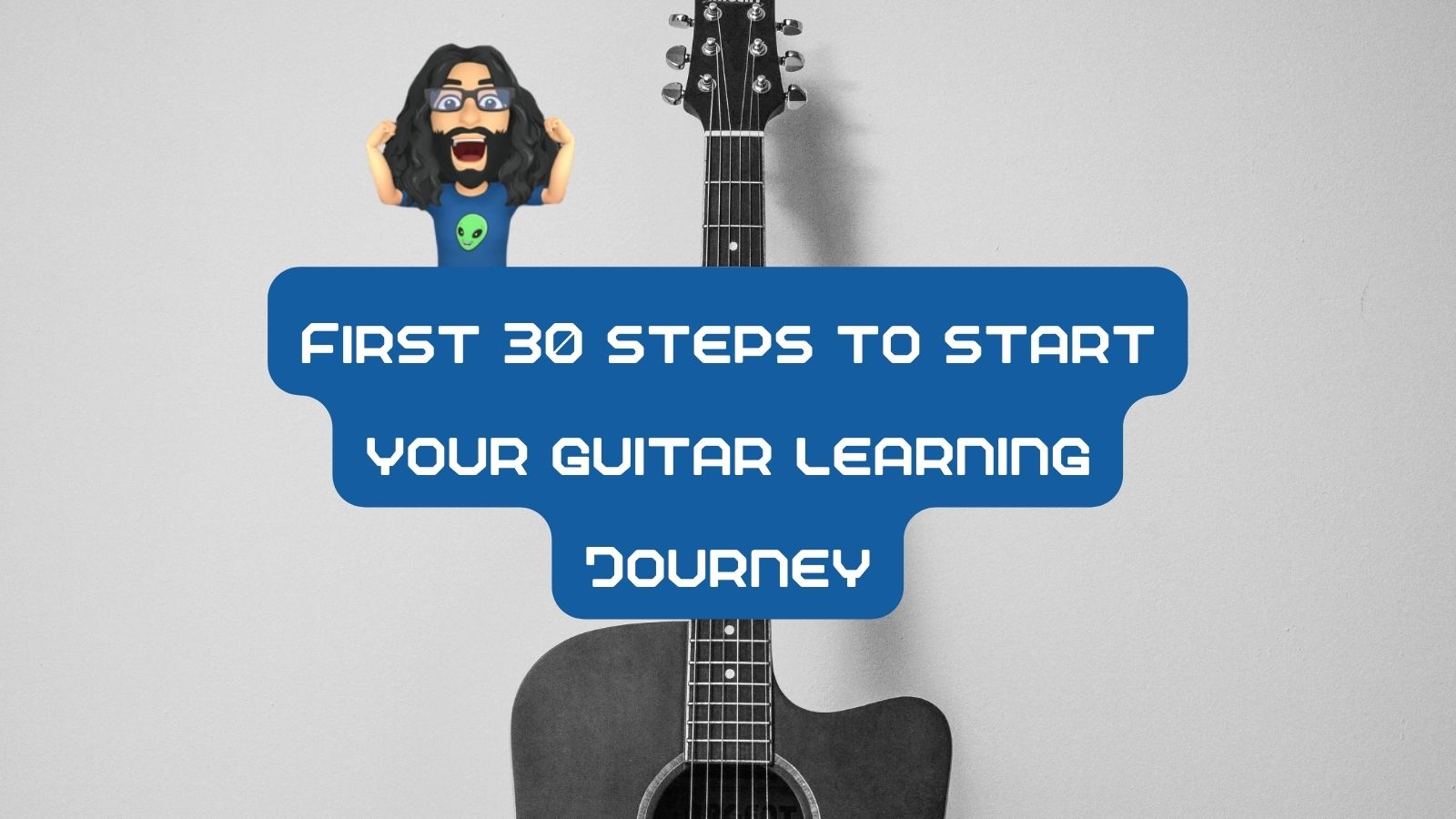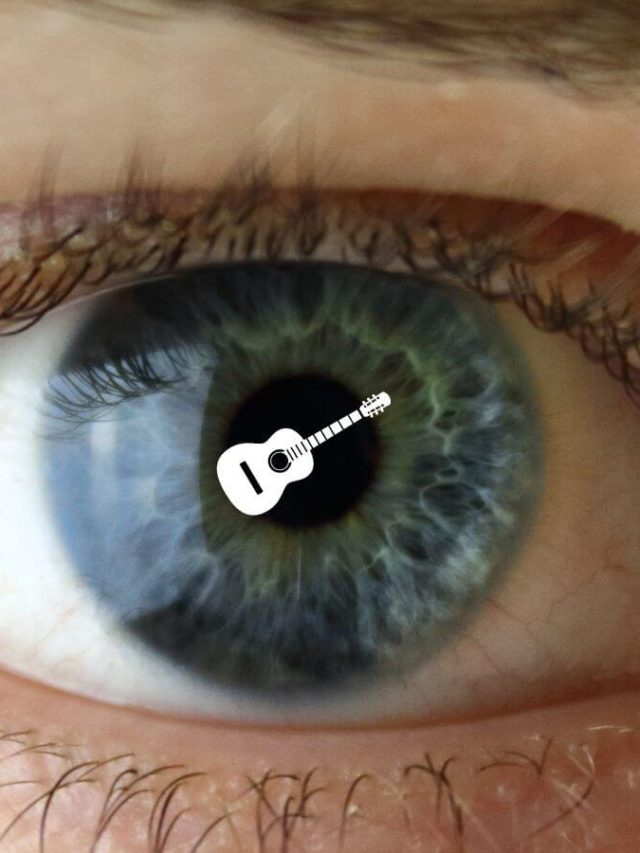You’ve started guitar today. You are buying a guitar. Now what do you do? I’ll give you an outline for what you can do for 30 days. If you are learning fast, consider these as the first 30 steps. Each point ahead is what you do per day or two. If you are satisfied with your progress, you can start working on future day’s material.
We have 3 goals at the start while learning guitar
- Learn to hold and place fingers on the guitar. The first barrier is always finger movement, not musical. Musical sense develops as a function of what you learn. Music is embodied that means it is inherently connected with movement through your fingers, body, or voice. So don’t worry about your musical sense at the start. You’ll learn it.
- Learn the type of sounds you can make and execute basic movements.
- Integrate the sounds with finger movements and create a set of building blocks. These building blocks are very important because the brain will use them again and again to add details to them, making them more sophisticated over time.
Things you’ll cover:
- Basic finger movements
- Chromatic and major + minor scale
- Chord progressions and transitions
- Simple musical sequences + nursery rhymes
- Bits of songs you like
- Basic melodic and rhythm sense
The first 30 steps/days
I’ll assume you have a guitar, a pick, internet access for Youtube, and 40 minutes a day to play.
Here’s my lesson plan to achieve these goals with a DIY approach via YouTube or Reels. As a general rule, I encourage you to make your music and do whatever you want on the guitar to make a musical sequence at every step. Combine and recombine or play snippets of what you know to make music. That joy will sustain you. Practice your own creations and modify them as you please over and above these learning steps.
Refer to Youtube videos. Google the meaning of things you don’t understand. Do everything I recommend in stretches of 20 min to 40 min. It’ll help if you spread out your practice over a twice-a-day routine. Always repeat the previous days work the next day. I’ve recommended the chords based on their ease of playing. Don’t rush too much. You need the REM sleep and rest to assimilate and accommodate your day’s learning in the brain. Think about what you played before sleeping. Pay attention to everything you do-all movements and sounds included.
- Play single notes at a time and strum open strings to get a feel of what you are to do on a guitar. Focus on posture, pick holding and how your hand looks, where to strum, how much pressure you add on the strings (pick should glide over the strings). Learn the E minor chord shape and do the same strumming. If you don’t have a guitar, get/borrow one. Do alternate picking on any fretted note at a comfortable pace. Today you explore and acquaint with your instrument. Watch pro videos and observe. Learn parts of the guitar and its tuning.
- Play the chromatic scale and do some basic finger exercises to build muscle strength. Try to pick as consistently as you can. Consistency needs muscle training. Learn the 12 chromatic notes. Repeat each note 8 times.
- Repeat day 2′s work and learn the C major chord. Focus on getting each note to sound clean.
- Repeat and practice changing the chords with a simple strum
- Same as above. Learn A minor. Learn basic terms used.
- Focus on chromatic notes. Choose a random note on the guitar and figure out which note it is.
- Learn to tune by carefully watching a video (if you are not confident, ask for help. If the guitar is not out of tune, and you aren’t confident, wait till day 15-20).
- Practice strumming those 3 chords you know and add D major to it. Work on improving your finger strength by doing chromatics, Repeat each note 4 times
- Focus on keeping your rhythm hand running and shifting chords with a simple strumming pattern
- Learn to play a major scale and minor scale on the open string
- Learn to play 1 octave of both a major and minor across strings
- By now, you should be comfortable playing chromatic notes without too many errors. Practice playing each chromatic note 2 or 1 times. Double your practice session. Chords in the second half.
- Learn 3 chords except F and G major/minor (barre chords). Practice strumming
- Learn 3 more chords. Practice strumming.
- Repeat. Look into the basic theoretical structure of a scale and its relevant chord. Learn the open G major chord.
- Refine what you’ve done so far – examples of chord groups
- Refine what you’ve done so far – explore strumming
- Refine what you’ve done so far – chord transitions
- Your finger strength should satisfactory now. Play triplets and quadruplets in 1 octave scale shapes
- Learn to play the second octave. Repeat the finger exercises
- Figure out the notes of each of your chords, introduce the metronome at a very slow BPM
- Refine everything – scales
- Refine everything – scale and chord exercises
- Play the songs “happy birthday to you” and some nursery rhymes.
- Learn simple melodies of songs you know
- More chord groups
- Repeat
- Learn to strum to songs
- Take up a simple song to play
- Reward yourself well if you can do all of this in 30 days (if you are at day/step 20-24 by now, don’t worry you are normal)
Its best to have a guitarist around you to get some quick clarification and to keep your playing habits in check. Theory is not important in the beginning. You’ll develop an intuitive grasp of the theory once you have the physical ability to play something.
This lesson plan follows 3 learning principles that are important for the brain to start something new:
- Spaced practice: Practicing sessions in small units of time with space in between improves learning better than doing everything in one go.
- Interleaving: Interleaving is learning 2 or 3 similar things together, which outperforms learning those sequentially.
- Chunking: Chunking is group small sensible units of learning, which outperforms long random practice sessions at the beginner level.
I’ve covered more guitar learning principles here.
Beginner guitarist’s FAQs
No, hands of any size can play on the guitar. 6-8 year-olds play guitar like a pro with their tiny hands; if they can, so can you. Stretching and flexibility develops as you learn, it’s not a prerequisite. If some movements are impossible, guitar is a flexible enough instrument to compensate for those.
No, your brain can learn at any age and it produces neurons and new neural connections up to 100 (if not more) years of age. It’ll be a little slower but your brain is equipped to make new finger movements and adapt at any age. Age is a psychological block, and only a slight physical disadvantage.
If you can afford it, get a guitar that excites you. This excitement is very important to keep you motivated. Don’t buy a premium guitar; you might not understand it’s premium-ness for a while. But a good entry guitar is fine.
You can buy a small body guitar or a 3/4th size classical guitar from a store. Go to a local store and see how different-sized guitars suit your body while sitting. Consider the guitar body’s thickness which ranges from 4.5cm (1.8 inches) to 10 cm (4 inches). Something around 2-3 inches is ideal for most beginners. It affects the “size” of the sound but it would hardly matter as a beginner.
Both forms of guitar are different from the point of view of holding them and learning them. If you are doing a DIY approach to guitar, go for a dreadnaught style or non-classical guitar. If you have a tutor who can teach you finger picking and posture, use a classical guitar.
You need a few picks in case you lose some. Extra strings incase you break them while tuning. Or if you have a store/luthier/friend near you, ask them for repair work you need because you broke your guitar. Strings are easy to fix and relatively cheap. They will likely only break if you are tuning very incorrectly.
Once you’ve covered the first 30 steps, you can start learning new scales, songs, chord patterns, strumming ideas, and keep doodling some musical phrases.
Once you are a little more advanced, try these neuroscience hacks to accelerate your learning.
And when you want to really create a unique signature sound as a guitarist, follow this guide.









